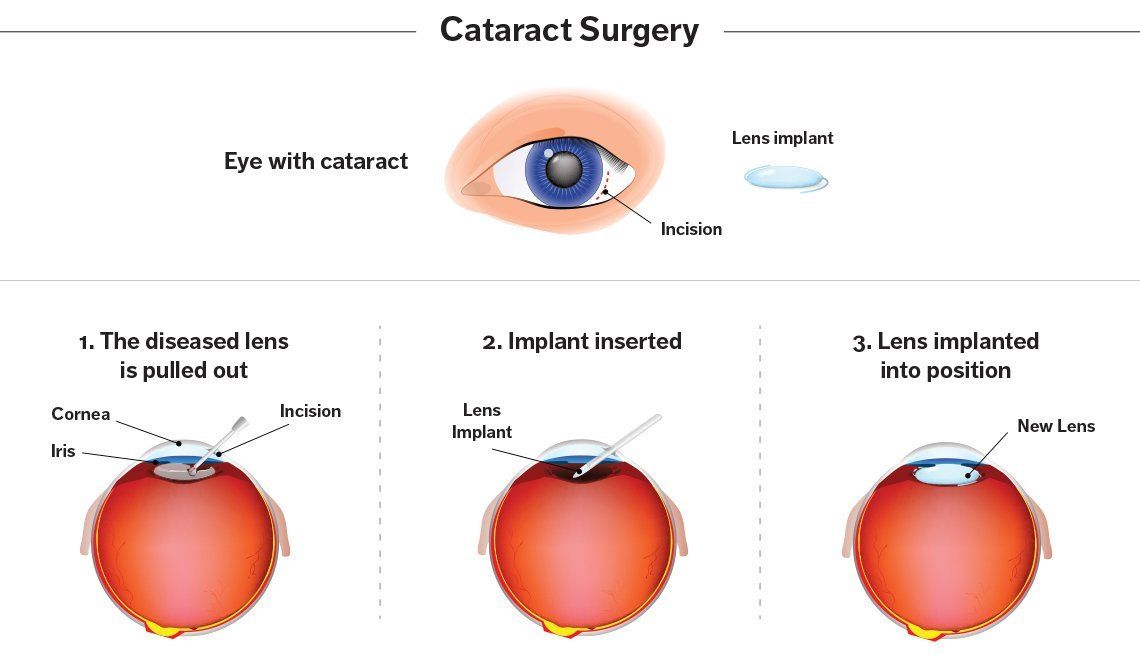What Is a Cataract?
How Will Removing the Cataract Affect My Vision?
Examinations Prior to Surgery
Pre-Operative Appointment
The Technician will review your medical history, review and obtain written consents required
before surgery, review instructions regarding eye drops that you will administer prior to and
after surgery, and answer any questions you have. You should expect to receive a phone call from our staff about 48 hours prior to your surgery date letting you know what time to arrive at the surgery center. Expect it to be fairly early in the morning. You will also be asked a few
questions and provided some additional instructions. We must have clearance from your
primary care physician for you to undergo surgery. Our office will fax them a request for this
clearance, and they may contact you to schedule an appointment for an examination in order
to clear you for surgery.
Need to Stop Wearing Contact Lenses Prior to Surgery
If you wear contact lenses, you must leave them out of your eyes for a period of time before
your preoperative eye examination and before your surgery. This is done because the
contact lens rests on the cornea and distorts its shape, which can affect the accuracy of the
doctor's measurement of the IOL power. When you stop wearing your contact lenses, the
corneas will return to their natural shape. Stop wearing soft contact lenses for 2 weeks and
rigid (including gas permeable and standard hard) contacts for at least three weeks. If you
wear rigid contacts, your vision will usually vary for a while as your cornea changes shape.
Although the cornea usually returns to its natural state within three weeks, this process may
take longer, and you will need to remain contact lens free until your vision and corneas
stabilize.
Your Vision After Cataract Surgery
There are several IOL options available to you to achieve distance and near vision after
cataract surgery.
An intraocular lens (IOL) is an acrylic lens that Is surgically implanted in the eye to replace the
existing clouded lens during cataract surgery. This is probably the most important decision
you need to make about your cataract surgery, so please take the time to review your options
and ask questions. The good news is that you've encountered cataracts at a time when
intraocular lens technology has taken great leaps of progress. Traditionally, the replacement
lens used for cataract surgery was a monofocal IOL. This type of lens restored good
functional distance vision, but people still needed to continue wearing reading glasses.
Today, you also have many options, including the AcrySof® IQ PanOptix® multifocal lens,
which can Improve vision In full range of distances, from near to far, and everywhere in
between.
Glasses
You can choose to have a monofocal (single focus) IOL implanted for distance vision and wear
separate reading glasses, or have the IOL implanted for near vision and wear separate glasses
for distance.
Monovision
The ophthalmologist could Implant IOLs with two different powers, one for near vision in one
eye and one for distance vision in the other eye. This combination of a distance eye and a
reading eye is called monovision. It can allow you to read without glasses. Many patients
who wear contacts or who have had refractive surgery have monovision and are happy with
it. Your surgeon will discuss and demonstrate this option to see if it might work for you.
Multifocal lOL
The ophthalmologist could Implant a "multifocal" IOL. This is a newer, "deluxe" type of IOL
that provides distance vision AND restores some or all of your eye's ability to focus at near. It
corrects for both distance vision and other ranges such as near and intermediate. Choosing
this option will usually lead to higher out of pocket expenses since most insurance companies
only pay for a monofocal (single focus) lens.
Information About Treating Astigmatism
Patient with nearsightedness and farsightedness often also have astigmatism. An
astigmatism is caused by an irregularly shaped cornea; instead of being round like a
basketball, the cornea is shaped like a football. This change in shape can make your vision
blurry. There are several treatment options for astigmatism: 1) you can have an IOL for near
or distance vision and continue to wear glasses or contact lens for the astigmatism; 2) you can
have a toric IOL placed in your eye, 3) you can have refractive surgery called Lasik or PRK.
The Day of Surgery
Please be sure to clean your face, and do not apply any makeup or lotions to your face before
arriving for surgery. Use all of your prescribed drops as instructed. Although the cataract surgery will only take about 15 minutes, expect to be at the surgery center for approximately
2 hours. Once the surgery is complete, you will receive instructions regarding drops to
administer, activity limits, lifting restrictions and post-operative appointments. You will not
be permitted to drive yourself home, so please make sure that you've arranged for a ride home.
Post-Operative Care
It Is very Important to follow the instructions you received regarding eye drops. You may
return to work on a light duty basis the day after surgery, provided you are able to attend
your post-operative appointment that day. Do not lift anything heavier than ten (10) pounds.
Do not rub or put pressure on your eye. Wear your eye shield while sleeping for 1 week. In
addition to the one (1) day post-operative appointment, you will have a one (1) week
appointment. Both of these appointments are very Important to the overall health of your
eye. If you are to have surgery on the other eye, it will likely be scheduled at the one (1)
week appointment.
Contact Granbury Eye Clinic to learn more.


Share On: